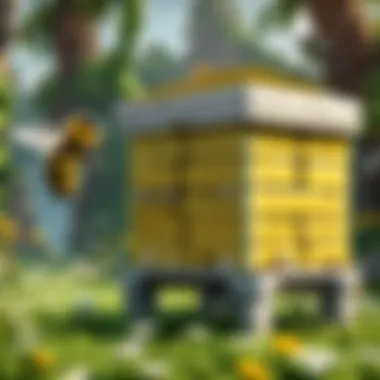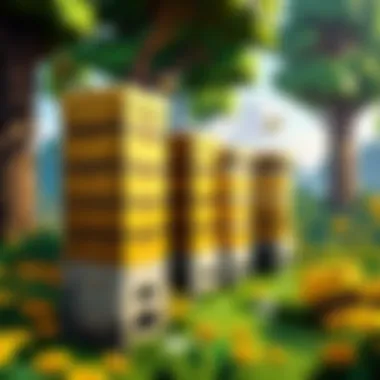Unlocking the Secrets to Acquiring Beehives: A Complete Guide


This article delves into the intricate process of acquiring beehives, an essential component of engaging in beekeeping activities. Beehives play a crucial role in providing a habitat for bees to thrive and produce honey, making them a must-have for anyone interested in beekeeping. Understanding how to obtain beehives is the first step towards a successful beekeeping venture.
Types of Beehives
Before delving into acquiring beehives, it's essential to familiarize oneself with the various types available in the market. From Langstroth hives to top bar hives, each type comes with its own advantages and considerations. Choosing the right hive type depends on factors such as beekeeping goals, location, and personal preference. Researching and exploring the different types can help aspiring beekeepers make an informed decision.
Purchasing Beehives
Once you've determined the type of beehive that suits your beekeeping endeavors, the next step is acquiring them. Beehives can be purchased from local beekeeping supply stores, online retailers, or directly from beekeepers. When purchasing beehives, ensure they are made of high-quality, durable materials to provide a safe and sturdy habitat for the bees. Consider factors such as hive size, ventilation, and ease of maintenance when making a purchase decision.
Setting Up Beehives
After obtaining the beehives, it's crucial to set them up correctly to ensure the bees' well-being. Choose a suitable location for the hives, ensuring they have access to sunlight, water sources, and vegetation for foraging. Properly assembling the hive components, such as frames, supers, and hive bodies, is essential for creating a conducive environment for the bees. Following a systematic approach to hive setup can help establish a thriving bee colony.
Caring for Beehives
Maintaining beehives involves regular inspections, monitoring bee health, and addressing any issues that may arise. Conducting routine hive checks, checking for pests and diseases, and ensuring the bees have an adequate food supply are essential aspects of beekeeping. Implementing best practices for hive management and bee care can contribute to the longevity and productivity of the bee colony.
Harvesting Honey
One of the rewarding aspects of beekeeping is harvesting the honey produced by the bees. Utilizing appropriate beekeeping equipment, such as smokers and bee suits, is crucial for a successful honey harvest. Adopting gentle and careful techniques during the honey extraction process is vital to ensure minimal disruption to the bees. Properly managing the honey extraction process maintains the hive's integrity and allows for a bountiful honey yield.
Introduction


Beehives are a vital component of beekeeping, serving as the central hub for bees to thrive and produce honey. In this comprehensive guide on acquiring beehives, we delve deep into the intricate art of beekeeping. Understanding the nuances of bee behavior and hive structures is essential for any aspiring beekeeper. Whether you are a novice or seasoned enthusiast, the journey of obtaining beehives encompasses various facets that are crucial for the well-being of your bee colony.
Types of Beehives
When embarking on the path of beekeeping, one must first recognize the different types of beehives available. From Langstroth hives to top-bar hives, each hive design presents unique advantages and considerations. The selection of the appropriate hive type depends on factors such as climate, bee species, and beekeeper preference. Delving into the specifics of each hive variant equips individuals with the knowledge needed to make informed decisions regarding their beekeeping venture.
Importance of Beehives
Beehives act as the heart of a bee colony, providing bees with a safe space to live, breed, and store honey. The intricate design of a beehive plays a crucial role in ensuring the well-being of bees and facilitating honey production. Understanding the significance of beehives enables beekeepers to create an optimal environment for their bees to thrive. By delving into the importance of hive ventilation, insulation, and structure, beekeepers can enhance the overall health and productivity of their bee colonies.
Understanding Beehives
Understanding Beehives is a crucial aspect of beekeeping, as it lays the foundation for successful hive management and honey production. By delving into the intricacies of bee behavior and hive structure, beekeepers can make informed decisions that benefit the overall health and productivity of their colonies. Understanding Beehives involves gaining knowledge about the various types of hives available, their pros and cons, and how each type caters to different bee species.
Types of Beehives
When it comes to beekeeping, choosing the right type of beehive is paramount. The Langstroth hive, for example, is widely used due to its practicality and scalability. Other options such as the Top-Bar hive and Warre hive offer alternative approaches that may suit beekeepers with specific preferences or environmental considerations. Each hive type possesses unique features that affect bee behavior, honey production, and maintenance requirements.
Importance of Beehives
Beehives play a pivotal role in supporting bee populations and ecosystem biodiversity. By providing a safe habitat for bees to thrive, beehives contribute to pollination activities essential for plant reproduction and food production. Additionally, beekeepers rely on beehives to harvest honey and other hive products, showcasing the economic significance of beekeeping. Understanding the importance of beehives encourages beekeepers to prioritize colony health, bee welfare, and sustainable beekeeping practices for long-term environmental benefits.
Setting Up Beehives


Setting up beehives is a crucial step in beekeeping that requires careful planning and execution. The process of establishing beehives plays a vital role in the overall success and productivity of your beekeeping venture. When it comes to setting up beehives, several key elements need consideration to ensure a conducive environment for the bees and optimize honey production. Proper hive placement and construction are essential for the well-being of the bees and the efficiency of your beekeeping operation.
Location Selection
Choosing the right location for your beehives is a critical decision that can have a significant impact on the health and productivity of your bee colony. When selecting a location for your beehives, several factors need to be taken into account. These include the availability of food sources, access to water, protection from harsh weather conditions, and proximity to blooming plants. Ideally, the location should provide ample sunlight, natural shelter from strong winds, and easy access for hive maintenance.
Constructing the Hive
The construction of the hive is a precise and intricate process that directly influences the comfort and functionality of the bee colony. Building a beehive involves attention to detail and adherence to specific guidelines to ensure the bees' well-being and the efficient operation of the hive. The hive structure should be sturdy, well-insulated, and equipped with proper ventilation to maintain optimal hive conditions. Utilizing quality materials and following established beekeeping standards is essential in constructing a hive that promotes bee health and honey production.
Acquiring Bees
Beehives are incomplete without the buzzing inhabitants themselves - the bees. Acquiring bees is a fundamental aspect of beekeeping that requires careful consideration and planning. In this section, we delve deep into the significance of acquiring the right bees for your hive, understanding their behavior, and ensuring a thriving colony.
Buying Bees
Buying bees for your beehive is a common practice among beekeepers to establish a new colony or replenish a dwindling one. When purchasing bees, it is crucial to source them from reputable suppliers to guarantee the quality and health of the bees. Factors such as the breed of bees, their genetic diversity, and disease resistance should be taken into account when selecting bees. Additionally, the transportation and acclimatization of purchased bees to their new hive must be managed meticulously to minimize stress and ensure a smooth integration into the colony.
Attracting Wild Bees
Alternatively, attracting wild bees to populate your beehive can be a thrilling and natural approach to beekeeping. Understanding the behavior and preferences of wild bees is essential in creating an environment that entices them to take up residence in your hive. Providing enticing habitats, such as hollow logs or bee swarm traps, and strategically placing them in areas with abundant nectar sources can increase the chances of attracting wild bee swarms. Patience is key when awaiting wild bees to settle in your hive, as they follow their own timeline and selection criteria based on factors like nest suitability and environmental conditions.
Managing Bee Diseases


Effective management of bee diseases is crucial for maintaining the health and vitality of honeybee colonies. Diseases and pests pose a significant threat to bee populations worldwide, impacting beekeeping operations and ecosystem stability. Beekeepers play a critical role in disease prevention, early detection, and treatment to safeguard their bees and the broader environment.
One key aspect of managing bee diseases is disease prevention through good beekeeping practices. Beekeepers should focus on maintaining hive hygiene, reducing stress factors, and promoting overall colony health to prevent disease outbreaks. Regular hive inspections, proper hive ventilation, and minimizing hive overcrowding are essential strategies for disease prevention.
Early detection of bee diseases is paramount in controlling and mitigating their spread within the colony. Beekeepers should familiarize themselves with common bee diseases' symptoms, such as foulbrood or varroosis, and regularly inspect their hives for any irregularities. Timely diagnosis enables beekeepers to implement appropriate treatment measures promptly, preventing disease escalation and colony losses.
Implementing integrated pest management (IPM) strategies is a sustainable approach to managing bee diseases and pests. IPM involves a combination of cultural, biological, mechanical, and chemical control methods to minimize the use of pesticides and preserve bee health and environmental balance. By adopting IPM practices, beekeepers can address disease pressures efficiently while safeguarding bee populations and ecosystem resilience.
Harvesting Honey
Harvesting honey is a crucial aspect of beekeeping that requires precision and care. In the realm of beekeeping, the process of harvesting honey holds immense significance, not just for beekeepers but also for the sustainability of bee colonies. The meticulous task of gathering honey from hives contributes to the well-being of bees and provides essential nourishment for both the insects and humans. Proper procedures in honey collection safeguard the bees and ensure the quality of the harvested product. Additionally, effective harvesting practices help maintain the harmony within the hive, promoting a thriving bee community.
Proper Harvesting Techniques
Mastering the art of proper harvesting techniques is fundamental for a successful honey harvest. Understanding the optimal time for honey collection, ensuring minimal disturbance to the bees, and employing the correct tools are essential components of proper harvesting techniques. By timing the harvest right, beekeepers can capitalize on peak honey production while respecting the natural rhythm of the bees. Minimizing disruptions during the harvest process preserves the hive's stability and minimizes stress for the bees, leading to healthier colonies. Utilizing the appropriate equipment for harvesting safeguard the integrity of the honey and aids in a smooth extraction process.
Extracting and Storing Honey
The extraction and storage of honey mark the culmination of the harvesting process, requiring careful attention to detail. Effectively extracting honey from combs involves using specialized equipment like extractors and uncapping knives to separate the honeycomb from the honey. Once extracted, proper storage methods are crucial to maintain the honey's freshness and quality. Adequate containers that are airtight and kept in a cool, dark place help preserve the flavor and nutritional properties of the honey. Proper labeling with harvest dates and bee species information further enhances the honey's value and ensures transparency in beekeeping practices.
Conclusion
In the world of beekeeping, the conclusion serves as a vital element that ties together the entire process of acquiring and maintaining beehives. This section is not merely an endpoint but a crucial reflection on the journey undertaken in beekeeping. Understanding the conclusion in the context of this article is akin to appreciating the culmination of efforts and dedication put into nurturing a bee colony.
An essential aspect highlighted in the conclusion is the holistic perspective it offers on the intricate world of bees. Through this section, readers grasp the significance of sustainable beekeeping practices in preserving the ecosystem and promoting biodiversity. Moreover, the conclusion encapsulates the broader implications of beekeeping beyond just harvesting honey, emphasizing the mutual relationship between humans and bees in pollination services.
One of the key benefits of delving into the conclusion is gaining insights into the challenges and rewards of beekeeping. It sheds light on the resilience of bees and the adaptability required from beekeepers to ensure the well-being of the hive. Additionally, the conclusion underscores the importance of continual learning and adaptation in response to changing environmental conditions and emerging threats to bee populations.
Furthermore, the conclusion serves as a reminder of the responsibility that comes with beekeeping. It underscores the ethical considerations involved in caring for bees and the role of beekeepers as stewards of these essential pollinators. By contemplating the implications discussed in the conclusion, readers are encouraged to approach beekeeping not only as a hobby but as a mindful practice that contributes to the greater ecological balance.
In essence, the conclusion segment of this article encapsulates the essence of beekeeping as a harmonious collaboration between humans and nature. It challenges readers to reflect on their role in sustainable beekeeping practices and to appreciate the intricate beauty of these pollinators. By exploring the conclusion in depth, individuals can gain a newfound appreciation for the delicate yet profound impact of beekeeping on the environment and society as a whole.



